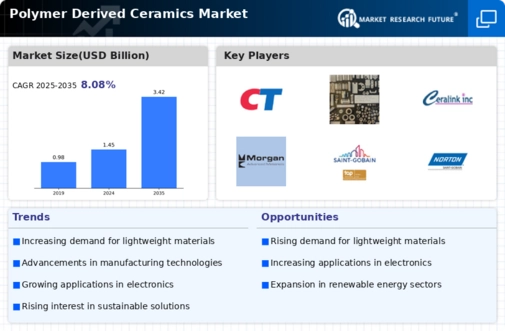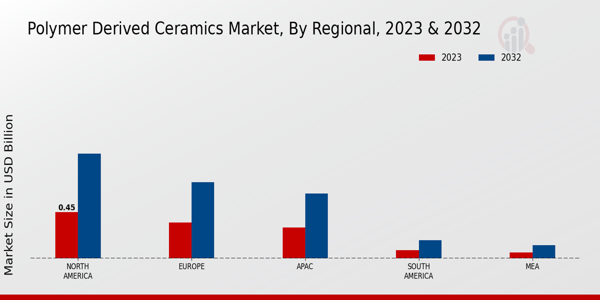Market Growth Projections
The Global Polymer Derived Ceramics Market Industry is poised for substantial growth over the coming years. With a projected market value of 1.45 USD Billion in 2024, the industry is expected to expand to 3.42 USD Billion by 2035. This growth trajectory suggests a compound annual growth rate of 8.1% from 2025 to 2035, driven by increasing demand across various sectors and advancements in manufacturing technologies. The market's expansion reflects the rising importance of polymer derived ceramics in meeting the evolving needs of industries worldwide.
Diverse Industrial Applications
The versatility of polymer derived ceramics contributes to their growing presence in the Global Polymer Derived Ceramics Market Industry. These materials find applications in various sectors, including aerospace, automotive, electronics, and healthcare. Their ability to withstand high temperatures and corrosive environments makes them suitable for demanding applications such as turbine components and medical implants. This broad applicability is expected to drive market growth, with the industry anticipated to expand significantly, reflecting the diverse needs of different sectors and the increasing reliance on advanced materials.
Growing Applications in Electronics
The Global Polymer Derived Ceramics Market Industry is witnessing a surge in applications within the electronics sector. The unique electrical and thermal properties of polymer derived ceramics make them suitable for use in insulators, substrates, and other electronic components. As the demand for miniaturized and efficient electronic devices continues to rise, manufacturers are increasingly turning to these materials. This trend is expected to bolster market growth, with the industry projected to reach a valuation of 1.45 USD Billion in 2024, driven by the expanding electronics market and the need for high-performance materials.
Rising Demand for Lightweight Materials
The Global Polymer Derived Ceramics Market Industry experiences a notable increase in demand for lightweight materials across various sectors, including aerospace and automotive. The shift towards lightweight components is driven by the need for improved fuel efficiency and reduced emissions. For instance, polymer derived ceramics offer a unique combination of low weight and high strength, making them ideal for applications in aircraft and electric vehicles. This trend is expected to contribute to the market's growth, with projections indicating a market value of 1.45 USD Billion in 2024, potentially reaching 3.42 USD Billion by 2035.
Increased Focus on Sustainable Materials
Sustainability concerns are becoming increasingly prominent in the Global Polymer Derived Ceramics Market Industry. Manufacturers are seeking eco-friendly alternatives to traditional materials, and polymer derived ceramics present a viable solution due to their potential for recyclability and lower environmental impact. This shift towards sustainable materials aligns with global initiatives aimed at reducing carbon footprints and promoting circular economies. As a result, the market is likely to benefit from this trend, with projections indicating a significant increase in demand as industries prioritize sustainability in their material choices.
Advancements in Manufacturing Technologies
Technological advancements in manufacturing processes significantly influence the Global Polymer Derived Ceramics Market Industry. Innovations such as additive manufacturing and advanced sintering techniques enhance the production efficiency and scalability of polymer derived ceramics. These technologies allow for the creation of complex geometries and tailored properties, which are essential for high-performance applications in electronics and biomedical fields. As a result, the market is likely to witness a compound annual growth rate of 8.1% from 2025 to 2035, reflecting the increasing adoption of these advanced manufacturing methods.










